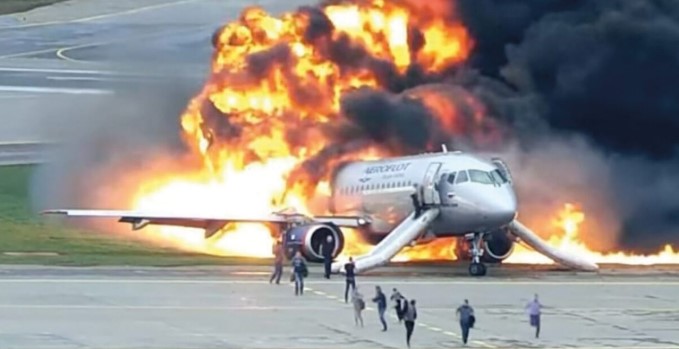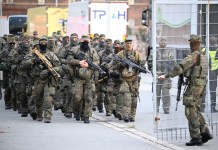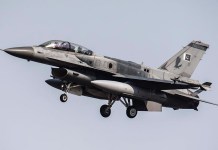In a significant development that will strengthen India’s civil aviation sector, Hindustan Aeronautics Limited (HAL) has signed a Memorandum of Understanding (MoU) with Russia’s state-owned aerospace company United Aircraft Corporation (UAC) to produce the Sukhoi SJ-100 civil commuter aircraft in India.
This will be the first time in nearly four decades that a civil aviation aircraft will be produced under license in India.
This is significant, as India is one of the world’s fastest-growing civil aviation markets.
Passenger traffic has been rising steadily, with domestic air passenger numbers reaching 161 million annually by 2024, and projections estimate 300 million by 2030.
India’s civil aviation sector is projected to require approximately 2,200 new commercial aircraft over the next 10 years (2025–2035) to support fleet expansion and replacement amid surging passenger demand.

Since India is currently wholly dependent on Boeing and Airbus for its commercial aircraft fleet, domestic passenger jet manufacturing will help New Delhi save billions of dollars in foreign reserves.
In the last two years, Indigo and Air India, two of India’s largest passenger carriers, have ordered more than 1,100 aircraft (Indigo: 560, Air India: 570) in deals worth more than US$100 billion.
These are among the largest civil airliner orders in history.
With the HAL-UAC deal, India can domestically produce many of the aircraft it would otherwise have imported.
While it is a big boost to India’s ‘Make in India’ program, questions are being asked about the safety record of SJ-100, and whether New Delhi should invest in an aircraft that has received minimal international orders since it entered into service in 2011.
The HAL-UAC Deal On Sukhoi SJ-100
The historic agreement that will pave the way for the domestic manufacturing of a civil airliner in India was signed in Moscow on October 28.
This will also be the first time that a complete passenger aircraft will be manufactured in India. The last such project carried out in India was HAL’s production of AVRO HS748, which started in 1961 and ended in 1988.
HAL was permitted to build the HS 748 under license, allowing it to make 89 aircraft, of which 72 went to the Indian Air Force and 17 to the national flag carrier, Indian Airlines.
The SJ-100
Currently in service with more than 16 commercial airlines, the SJ-100 is a twin-engine, narrow-body aircraft. Over 200 such aircraft have already been produced.
According to the HAL statement, “SJ-100 will be the game changer for short-haul connectivity under the UDAN Scheme in India. Under this arrangement, HAL will have the rights to manufacture SJ-100 aircraft for domestic customers.”
“This collaboration stands as a testament to the mutual trust and long-standing partnership between HAL and UAC,” the companies said in a statement. “It marks a new milestone in India’s journey towards becoming self-reliant in civil aircraft production.”

Trump ‘Slams’ $13B USS Gerald R Ford’s EMALS Tech; Orders Steam Revival As China’s Fujian Masters It
According to HAL’s estimates, over the next ten years, the Indian aviation sector will require more than 200 jets for regional connectivity alone.
The passenger jet is a relative newcomer to the civil aviation market.
The aircraft had its first flight in May 2008, and it entered service in April 2011. The jet has a seating capacity ranging from 87 to 108 seats.
In 2013, the jet received its first international order when Mexican carrier Interjet placed an order for 22 aircraft.
So far, over 230 aircraft have been constructed with 16 airlines flying the SJ-100. However, most of these airlines operate within Russia.
Of these, nearly 180 are flying within Russia, and almost 40 have gone to international customers, including Armenia, Thailand, and Kazakhstan.
While HAL has not disclosed how many aircraft will be built in India under the agreement, in all probability, India will become the biggest international customer of the Russian passenger jet.
Therefore, it is worth reviewing SJ-100’s safety record.
Is the Sukhoi Superjet safe?
At the outset, it must be noted that there is not much data on the safety record of SJ-100.
The aircraft entered service only in 2011, and the jet has mostly flown within Russia.
Since Russia invaded Crimea in 2014, and sanctions were imposed on Russia, it has stopped sharing information with the West.
In this short time, the aircraft has been involved in 95 recorded incidents, according to the Aviation Safety Network (ASN), five of which resulted in complete hull losses. Three of these incidents led to fatalities, with the SJ-100 claiming 89 lives.
Five hull losses in this short time is a significant number.
The first fatal accident took place in 2012. Sukhoi was taking a batch of prospective customers, staff, and journalists on a demonstration flight over Indonesia when the aircraft crashed into Mount Salak, killing all 45 occupants.
A subsequent investigation blamed pilot error for the fatal accident.
The second incident happened in 2015 in Mexico, when an SJ-100 plane crashed into another while it was being towed from the runway to the hangar. Since the plane was empty at the time, there were no fatalities. Human error caused the accident.
The third incident happened in 2018 when a Sukhoi Superjet was written off after landing at Yakutsk Airport (YKS) in Russia. The aircraft overran the operable runway and entered an area under construction.
No fatalities were reported, but the aircraft suffered significant damage. Again, pilot and operator error, along with icy conditions at the airport, were blamed. Investigations concluded that the aircraft was dispatched with one thrust reverser inoperable.
The accident that raised the most concern for the safety of the SJ-100 occurred in May 2019 at Moscow’s Sheremetyevo Airport (SVO).
The Aeroflot flight with aircraft RA-89098 was leaving Moscow for Murmansk Airport (MMK) but returned to the airport shortly after takeoff.
It came in much too fast and touched down late and hard. The force of the hard landing caused it to bounce back up by about 2 meters, rupturing the wing and the fuel line. A fire broke out and quickly engulfed the rear of the plane, claiming 41 of the 78 lives on board, Aerotime reported.

The investigation is still ongoing, with some reports suggesting the aircraft may have been struck by lightning.
The last incident happened last year. The aircraft, which was on a test flight, crashed into a wooded area, killing all three crew on board. Investigation is still ongoing.
In three of the five hull loss cases, human error was blamed. The last two incidents, where the probe is still ongoing, appear the most serious. However, it won’t be surprising if even in these cases, human error is blamed.
Most of the remaining 90 incidents were minor in nature, with only two resulting in significant aircraft damage.
According to Aviation Safety Network and Aerotime, in most of these cases, the causes were pretty innocuous.
Tracking Putin’s Submarines: Germany To Bolster Its Sub-Hunting Capabilities To Combat Russian Navy
In 56.8% cases, an aircraft fault was responsible, human error was responsible in 21.1% cases, natural events in 15.8% cases, and causes were unknown in 6.3% cases.
However, this number, while significant, is not an outlier in civil aviation.
The Boeing 787-9 Dreamliner, for example, was only introduced in 2013 and now has a fleet of just under 650 aircraft in operation. ASN tracks 134 reports of issues with this model, most of which are minor aircraft faults.
The five hull losses over 14 years, with nearly 0.5-0.8 million flying hours, are significant; however, human error was responsible in three cases. The remaining two incidents, still under investigation, are more serious.
However, given that the aircraft is in its early days, this number is not an outlier in the history of civil aviation.
According to Simple Flying, the Moscow Sheremetyevo incident highlighted potential design flaws in the SJ100. The rapid fire spread following the hard landing suggests that improvements in the aircraft’s fire containment systems may be necessary.
However, none of the other hull-loss incidents revealed any significant design flaws.
Furthermore, Russia has redesigned many parts that were earlier imported from Western countries.
The ‘Russified’ SJ-100R had its first flight in 2023. It remains to be seen what the safety record of this Russified SJ-100R will be.
However, given the SJ-100’s track record over the last 14 years, it can be safely said that the SJ-100 is safe, having undergone the same rigorous testing and certification as all commercial aircraft.
The aircraft has indeed received minimal international orders in the last 14 years. However, this might not be because of any inherent design flaws or technical issues in the aircraft, but rather a result of the unprecedented sanctions on Russia in the wake of the Ukraine War.
The aircraft entered service in 2011, and sanctions against Russia were imposed in 2014. Russia’s full-fledged invasion of Ukraine in 2022 triggered further sanctions.
On March 15, 2022, the EU formally designated UAC under its Ukraine sanctions regime, citing its control over 100% of Russia’s military aircraft production—jets actively deployed in the conflict.
The UAC is also under U.S. and British sanctions and is described by the U.S. Treasury as a key enterprise in Russia’s military-industrial complex. It is quite possible that had it not been for the Ukraine War, the SJ-100 might have won many other international orders.
- Sumit Ahlawat has over a decade of experience in news media. He has worked with Press Trust of India, Times Now, Zee News, Economic Times, and Microsoft News. He holds a Master’s Degree in International Media and Modern History from the University of Sheffield, UK.
- VIEWS PERSONAL OF THE AUTHOR.
- He can be reached at ahlawat.sumit85 (at) gmail.com




